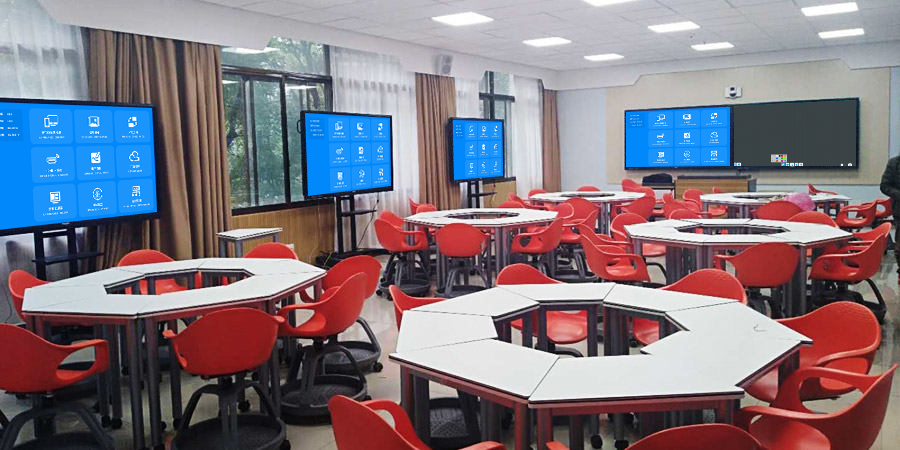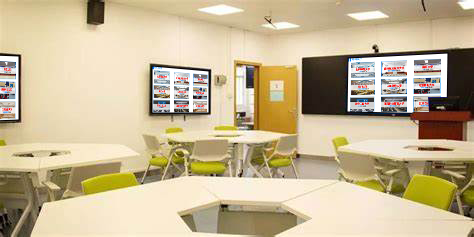Smart Classrooms: Revolutionizing the Educational Experience and Reshaping Teaching Paradigms
In today’s wave of digital education, smart classrooms are progressively replacing traditional classrooms, becoming a core force driving teaching transformation. They integrate advanced technology with innovative educational concepts, offering teachers and students an unprecedentedly efficient and interactive learning experience.
I. Convenient Wireless Connection: Instantly Kickstart Lessons
- Breaking Free from Cables: In traditional classrooms, teachers often spend significant time plugging in cables and debugging interfaces to connect computers, projectors, and document cameras. This process is cumbersome and prone to errors. In a smart classroom, teachers only need their phone, tablet, or laptop. Using wireless screen mirroring technology, they can instantly display teaching materials on the classroom’s large screen. Whether it’s a presentation, a video, or real-time photos, content appears quickly, transforming lesson preparation from “time-consuming and laborious” to “effortless one-click.” For instance, during a language arts class, if a teacher suddenly wants to show an external article, they can simply take a photo with their phone and mirror it, guiding students to read and discuss with a smooth, natural teaching pace.
- Multi-Device Simultaneous Connection: Smart classrooms support multiple devices mirroring simultaneously. During group discussions, each group can project their discussion results and solution ideas onto the main screen concurrently, allowing the entire class to visually compare different groups’ ideas and foster intellectual exchange. For example, in a mathematical modeling course, groups can project their developed models and problem-solving approaches, while the teacher and other students provide real-time feedback, significantly improving discussion efficiency and depth.

II. Full Platform Compatibility: Adapting to Diverse Teaching Tools
- Seamless System Compatibility: Teachers and students use a wide variety of devices and operating systems. The smart classroom’s mirroring system is perfectly compatible with mainstream operating systems like Windows, macOS, iOS, and Android. Whether it’s a science teacher using a Windows computer, a humanities teacher accustomed to teaching with an iPad, or students with Android tablets, all can seamlessly connect to the smart classroom’s mirroring network, ensuring diversity and flexibility in teaching tools.
- Flexible Adaptation to Teaching Software: Whether it’s commonly used software like PPT or WPS presentations, or specialized subject-specific teaching software such as virtual experiment software for chemistry or map analysis software for geography, the smart classroom can run and display them smoothly. Furthermore, it can be deeply integrated with online teaching platforms like Tencent Classroom and Yu Ketang, allowing for easy switching between online and offline teaching. During the pandemic, many schools adopted a hybrid online and offline teaching model, and smart classrooms easily adapted to various online teaching software, ensuring teaching continuity.
III. High-Definition Interactive Experience: Igniting Learning Enthusiasm
- 4K Ultra HD Visuals: When displaying teaching content such as experimental details, artwork, or geographical features, visual clarity is paramount. Smart classrooms utilize advanced display technology to support 4K ultra-high-definition mirroring, allowing students to clearly see the microscopic structure of cells, the brushstrokes of a painting, or the details of mountains and rivers. This concretizes abstract knowledge, helping students better understand and absorb information. In a biology lab class, students can clearly observe the entire process of cell division through ultra-high-definition mirroring, enhancing learning effectiveness.
- Real-time Interactive Functions: Smart classrooms are equipped with interactive features like electronic whiteboards, annotations, quick answers, and polling. While the teacher explains, they can make real-time annotations on the projected content. Students can participate in quick answers and polls using their devices to express their views. In a history class, after the teacher presents historical event materials, they can launch a poll asking students to choose the impact of the event, livening up the classroom atmosphere. At the same time, the teacher can instantly understand students’ grasp of knowledge points and adjust the teaching pace.

IV. Teaching Data Retention: Supporting Precise Instruction
- Comprehensive Learning Process Recording: The smart classroom system automatically records various in-class data, including student interaction participation (number of quick answers, speaking duration), assignment completion, and quiz results. By analyzing this data, teachers can clearly understand each student’s learning progress and knowledge weaknesses, providing a basis for personalized tutoring. For example, in an English class, the system records students’ accuracy in spelling words and answering grammar questions, allowing the teacher to create a tailored review plan for each student.
- Visualized Teaching Effectiveness: Based on a large amount of teaching data, visual reports are generated, intuitively presenting the overall learning status of the class and the distribution of mastery levels for different knowledge points. Teachers can compare teaching data across different classes and semesters to evaluate the effectiveness of teaching methods, summarize experiences, and optimize teaching strategies. School management can also use this data to understand the overall level of teaching quality, providing decision support for allocating teaching resources and teacher training.
V. Flexible Scenario Application: Meeting Diverse Teaching Needs
- Regular Classroom Teaching: Suitable for daily teaching across all subjects, teachers can utilize rich teaching resources, convenient mirroring, and interactive functions to create lively and engaging lessons. In a physics class, the teacher can project an experimental video, explain principles using the electronic whiteboard, and engage students in interactive quizzes to deepen their understanding of knowledge.
- Group Discussion Teaching: In collaborative group learning, the smart classroom’s multi-screen linkage and group screen interaction facilitate communication and discussion among group members and allow for shared materials. For instance, in project-based learning courses, groups can display research materials and discuss solutions on their group screens, finally projecting their results to the main screen for a class report.
- Remote Interactive Teaching: With the smart classroom’s remote connection capabilities, it can facilitate remote interaction with other classrooms, schools, or even international institutions. Schools in remote areas can connect remotely with teachers from prestigious schools to share high-quality educational resources. In international exchange programs, students from different countries can communicate in real-time about culture and academic viewpoints, broadening their horizons.
